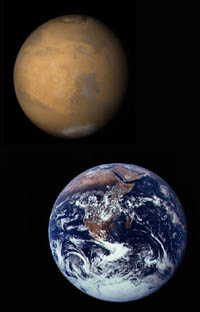 |
 |

The two Viking landers in the 1976-1982 period used both DTE and relays through the Viking orbiters to communicate with Earth. The Mars Pathfinder in 1997 only used DTE, because when the spacecraft was designed it was understood that there would be no orbiter in place to relay the data. Mars Observer (MO) carried a French-supplied ultra-high frequency(UHF) antenna and electronics to relay data from two French-built balloons and two small Russian-built landers on the Soviet Mars '92 mission, but the Mars '92 mission was never launched and MO was lost. MGS carried a copy of the MR, intended to relay data from two small landers on the Russian Mars '96 mission, but Mars '96 was lost shortly after launch.
Mars Polar Lander, Deep Space 2
An antenna large enough to communicate directly to Earth from Mars was included on the Mars Polar Lander (MPL). However, such an antenna would be much too large for the two Deep Space 2 Microprobes, thus these small spacecraft were designed to communicate only through the MGS relay.
MPL data were mostly going to be sent to Earth by relaying through the Mars Climate Orbiter (MCO), which carried an improved UHF system built in the United States specifically for Mars relay activities. MCO was sent ahead of the lander so that it would be in position to support the lander mission in December 1999. However, Mars Climate Orbiter was lost as it arrived at Mars because it came too close to the planet during its attempt to enter orbit and either broke up or burned up in the atmosphere. After that failure, MGS was pressed into service to provide a backup capability via the MR to MPL's DTE capability. On 3 December 1999, MPL crashed into the martian surface, and the Deep Space 2 microprobes were never heard from, either.
The two Mars Exploration Rovers (MER) relied on three paths to retun data to Earth: DTE, relay through the Mars Odyssey orbiter, and relay through MGS. Daily DTE sessions were originally planned to be the primary means of sending commands to the MERs and returning high-priority engineering and science planning data to Earth. Twice-a-day overflights by both Odyssey and MGS provided the primary path for the large volumes of science data during the Primary and early Extended Mission. However, during the majority of the Extended Mission, only Mars Odyssey has been used. MGS overflies each MER in the early afternoon and early pre-dawn hours (between 1-2 PM and 1-2 AM), while Odyssey overflies each MER in the late afternnon and just before dawn (4-5 PM and 4-5 AM). MGS and the Mars Relay (MR) use the MR protocol; Odyssey uses a different approach. The MERs are capable of using either.
After the loss of MPL, NASA mandated that engineering telemetry be available from a spacecraft during any critical event. Landing on Mars is such a critical event. Originally, it was thought that the MERs could communicate directly to Earth during the entry, descent, and landing (EDL) and, indeed, each MER did maintain a low level of communications during that period. Because the landing system was spinning and in otherwise unknowable orientations, only the radio carrier signal was received. But by modulating that signal in fixed ways, that signal had different "tones" indicating when an event occurred and when the spacecraft has entered a specific state. Sometimes called "semaphores" (after the 19th century technology of using flags or similar mechanisms to signal messages based on their visual patternor location), these tones signify, for example, when the parachutes and airbags have deployed and if the lander is resting on its base after it rolls to a stop.
However, while semaphores can tell you the status of the landing, they convey insufficient information to reconstruct what actually happened, so an additional means was needed to return real telemetry from the descent until landing. Examination of the two orbits followed by MGS and Odyssey showed that Odyssey would not be able to communicate with each MER vehicle until several hours after it landed, but that MGS was in an orbit with which each vehicle could communicate during the EDL phase. The MGS orbit needed some minor tweaking: the predicted orbit showed that MGS would overfly the site about 1 hr after landing, so the orbit period was adjusted by about 3 seconds per orbit in early October 2003 to advance the spacecraft along its orbit so that it would be passing the MER-A lander just as it touched down. A similar small adjustment was used to place MGS near the MER-B lander when it reached Mars in late January 2004.
Image Credits--- Mars: NASA/JPL/MSSS; Earth: NASA/JSC; Composite: MSSS